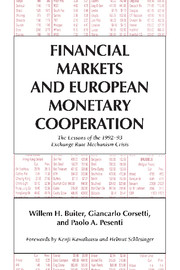 Financial Markets and European Monetary Cooperation
Financial Markets and European Monetary Cooperation Published online by Cambridge University Press: 06 July 2010
Building blocks of a systemic theory
By focusing the analysis on the role of international spillovers and policy games, Chapter 8 has concluded our journey through the conceptual and analytical dimensions of the literature on currency crises. The goal of Chapter 9 is to assess the ERM crisis from the perspective of our Center–Periphery model. We start in this section by reviewing our analysis of the role of policy coordination in a currency crisis. In Section 9.2, we provide a detailed reinterpretation of the 1992–1993 events in the light of our results. While the formal analysis in Chapters 6 through 8 will instruct our reading of the crisis, in what follows we will widen the scope of the discussion beyond the strict boundaries of our model and consider additional elements that, for the sake of analytical tractability, were not incorporated into our formal analysis.
It may be helpful to restate the main features of our theoretical framework. Our construction conforms to the traditional view of the ERM as a way of borrowing or importing anti-inflationary credibility from Germany (the consensus view at the time of the crisis). Since individual Periphery countries are affected by an inflationary bias, they agree on the desirability of limiting exchange rate flexibility. The international exchange rate agreement provides the commitment technology that policy makers cannot find at home, although such a commitment is known to be less than perfect and market participants perceive the abandonment of the peg as a possible policy option in the presence of domestic or external shocks.
To save this book to your Kindle, first ensure no-reply@cambridge.org is added to your Approved Personal Document E-mail List under your Personal Document Settings on the Manage Your Content and Devices page of your Amazon account. Then enter the ‘name’ part of your Kindle email address below. Find out more about saving to your Kindle.
Note you can select to save to either the @free.kindle.com or @kindle.com variations. ‘@free.kindle.com’ emails are free but can only be saved to your device when it is connected to wi-fi. ‘@kindle.com’ emails can be delivered even when you are not connected to wi-fi, but note that service fees apply.
Find out more about the Kindle Personal Document Service.
To save content items to your account, please confirm that you agree to abide by our usage policies. If this is the first time you use this feature, you will be asked to authorise Cambridge Core to connect with your account. Find out more about saving content to Dropbox.
To save content items to your account, please confirm that you agree to abide by our usage policies. If this is the first time you use this feature, you will be asked to authorise Cambridge Core to connect with your account. Find out more about saving content to Google Drive.